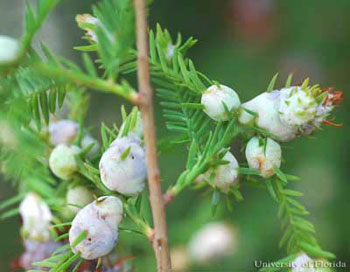Cypress twig gall midge
Taxodiomyia cupressiananassa
Natural History

Galls caused by cypress twig gall midge
Photo credit: Russel F. Mizell III, University of Florida
The cypress twig gall midge (Taxodiomyia cupressiananassa) infests bald cypress (Taxodium distichum), pond cypress (T. ascendens) and Montezuma cypress (T. mucronatum) in the U.S. from Illinois to Florida and Louisiana. The adults are tiny flies that lay eggs in developing foliage. A gall forms as larvae develop and up to 16 eggs are found per gall. The insect overwinters as larvae in galls that drop from trees during the winter. The pupae develop in spring and adults emerge in summer. Up to 2 generations per year are common in Florida. Many predatory insects prey on the cypress twig gall midge and certain genetic lines of bald cypress have resistance to the insect.
